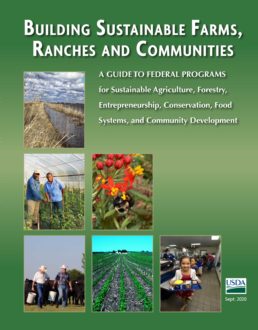This guide lists funding opportunities offered by federal programs, and is indispensable for anyone seeking government help to foster their innovative enterprise in forestry and agriculture.
Specifically, it addresses program resources in community development; sustainable land management; and value-added and diversified agriculture and forestry. Thus, it can help farmers, entrepreneurs, community developers, conservationists, and many other individuals, as well as private and public organizations, both for-profit and not-for-profit.
The guide can also help USDA and other agency employees become aware and take better advantage of the enormous array of federal programs and resources available to their clients in supporting agricultural and forestry innovations. This edition constitutes the guide's sixth printing and fourth complete update, incorporating programs from the 2018 Farm Bill.
Building Sustainable Farms, Ranches, and Communities was produced through the collaboration of SARE, the Michael Fields Agricultural Institute (MFAI), the National Center for Appropriate Technology (NCAT), and the National Sustainable Agriculture Coalition (NSAC). Funding was provided by SARE, the Agricultural Marketing Service (AMS) and the McKnight Foundation.
Additional Resources
The more in-depth Grassroots Guide to Federal Farm and Food Programs is available online through the National Sustainable Agriculture Coalition.
Looking for key Farm Bill programs that can help sustainable agriculture farmers? Check out the National Sustainable Agriculture Coalition's Farmers’ Guide to USDA Programs and Resources.
This material is based upon work that is supported by the National Institute of Food and Agriculture, U.S. Department of Agriculture through the Sustainable Agriculture Research and Education (SARE) program. Any opinions, findings, conclusions, or recommendations expressed in this publication are those of the author(s) and should not be construed to represent any official USDA or U.S. Government determination or policy.
